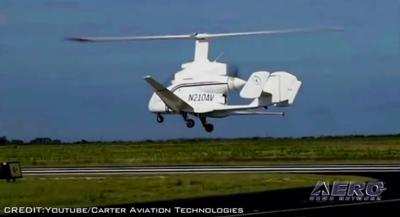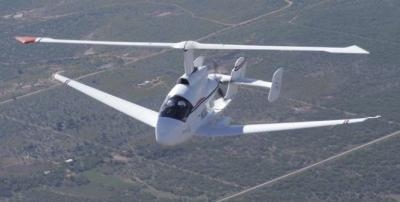Tue, Sep 15, 2015
Presentation Made At European Rotorcraft Forum In Europe
Carter Aviation Technologies last week made a presentation to the European Rotorcraft Forum in Munich Germany.

The European Union has been working on a program called Clean Sky for several years. This program seeks to improve environmental aspects of air transportation with reductions in CO2 emissions and noise pollution among the objectives. Recently, Clean Sky 2 was initiated with a consortium of participates, a multi-year plan, and a budget of around €4 billion between the European Union and industrial partners. Some of the loftier goals are a 20%-30% reduction in CO2 emissions and noise pollution with a 2014 technology baseline.
“I think we surprised a lot of folks in Munich. They’re workin a multi-year plan to create more environmentally-friendly aircraft and here we sit at Carter with a technology that achieves a reduction in CO2 between 66% [hovering aircraft] and 80% [jump takeoff aircraft],” expounded Jay Carter. “Our presentation created quite the buzz and we expect to be expanding our list of parties interested in learning more about our technology.” Carter’s Personal Air Vehicle or PAV pictured above has achieved an L/D of 11 and the potential to design an aircraft for an L/D of 16 is possible. The reduction in rotor drag achieved with the dramatic slowing of the rotor from a nominal takeoff maximum of 400 rpm to a cruise flight rotation of 100 rpm enables this level of cruise efficiency.

The idea of slowing the rotor down in flight is not new. In the 1930’s, aerodynamicists looking to improve upon autogyro efficiency recognized that if the rotor could be slowed down and kept stable, fantastic rotorcraft performance could be achieved in cruise. In the late ‘50s and early ‘60s, both the US and British governments spent years and millions of dollars trying to significantly slow the rotor. They had some success, but because
of noise, vibration, stability, and control issues, it was concluded to be either impossible or impractical. “We have been working the slowed rotor program for 21 years. It took 11 years before we first achieved an advance ratio of one. We had to identify and solve 10 issues to safely slow the rotor – the subject of 22 patents and 6 pending,” stated Jay Carter. The Carter presentation in Munich discussed those issues and the performance results from flight testing that have exceeded the emission and noise goals of Clean Sky 2.
(Images from file)
More News
Runway Centerline Lighting Flush centerline lights spaced at 50-foot intervals beginning 75 feet from the landing threshold and extending to within 75 feet of the opposite end of t>[...]
Aero Linx: Air Force Global Strike Command Air Force Global Strike Command, activated August 7, 2009, is a major command with headquarters at Barksdale Air Force Base, Louisiana, i>[...]
Also: Viasat-uAvionix, UL94 Fuel Investigation, AF Materiel Command, NTSB Safety Alert Norges Luftsportforbund chose Aura Aero's little 2-seater in electric trim for their next gli>[...]
Also: USCG Retires MH-65 Dolphins, Irish Aviation Authority, NATCA Warns FAA, Diamond DA42 AD This summer, history enthusiasts will have a unique opportunity to experience World Wa>[...]
Also: Moya Delivery Drone, USMC Drone Pilot, Inversion RAY Reentry Vehicle, RapidFlight UAVOS has recently achieved a significant milestone in public safety and emergency services >[...]
 ANN's Daily Aero-Term (04.30.24): Runway Centerline Lighting
ANN's Daily Aero-Term (04.30.24): Runway Centerline Lighting ANN's Daily Aero-Linx (04.30.24)
ANN's Daily Aero-Linx (04.30.24) Airborne 04.24.24: INTEGRAL E, Elixir USA, M700 RVSM
Airborne 04.24.24: INTEGRAL E, Elixir USA, M700 RVSM Airborne 04.29.24: EAA B-25 Rides, Textron 2024, G700 Deliveries
Airborne 04.29.24: EAA B-25 Rides, Textron 2024, G700 Deliveries Airborne-NextGen 04.23.24: UAVOS UVH 170, magni650 Engine, World eVTOL Directory
Airborne-NextGen 04.23.24: UAVOS UVH 170, magni650 Engine, World eVTOL Directory




